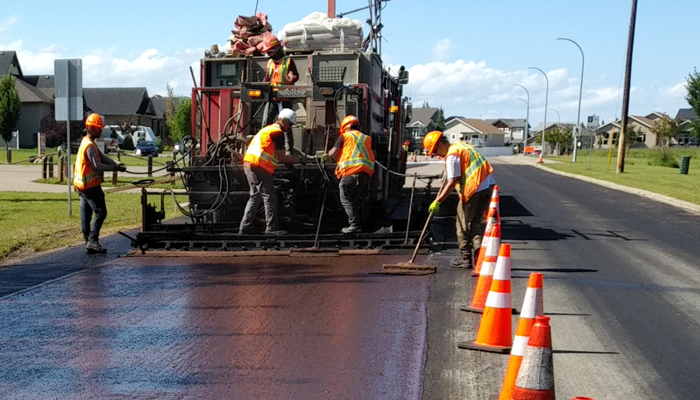Micro-surfacing

Micro-surfacing is a thin but durable surface treatment used to preserve existing asphalt roadways without the cost and inconvenience of full pavement surface removal and replacement. It is used to both preserve and restore existing asphalt by sealing the surface to minimize water infiltration and preventing further oxidation (natural weathering) of the pavement surface.
Although visually it may appear similar to the pavement surface that roadway users are familiar with, it is not a new asphalt pavement once completed. It is most often applied across the entire surface of the weathered or worn roadway, but as it is not compacted during placement, it initially has a rough looking texture with some loose aggregates. This is considered to be normal for this treatment, and as vehicles drive over the surface, it will smooth out.
In addition to sealing the asphalt surface, micro-surfacing can be used to correct minor rutting issues and also improve the skid resistance of the pavement surface. This process allows us to keep good roads in good condition so we can reallocate funding to roads that are in higher need of repaving or reconstruction. It is another tool which can be used to maintain our asphalt surfaced roadways, with a goal of minimizing capital and operational costs yet maximizing the pavement lifecycle.
Micro-surfacing benefits
- Can extend pavement surface life by five to eight years.
- Seals the minor surface cracks that develop over the life of the pavement thereby reducing the penetration of water into the pavement.
- Slows down the adverse impacts of weathering of the aging asphalt surface (oxidation leading to the development of potholes).
- Helps to increase friction of the pavement surface, improving skid resistance for motorists.
- Potential treatment to address rutting of the pavement surface.
- Installs faster than traditional paving which minimizes the traffic impacts and delays associated with road construction. Often the roadway can be re-opened to traffic within a few hours of the treatment.
The process
In general, roadway users can anticipate the following to occur once traffic control is in place:
- Crews repair existing wide cracks and pothole/distress areas on the existing asphalt surface.
- Old rubberized crack sealant materials and permeant thermoplastic pavement markings are removed from the surface.
- The street is swept clean.
- The surface is sprayed with a tack coat to allow for a better bond between the existing surface and the micro surface product.
- A specialized machine spreads the thin layer of micro-surfacing treatment.
- The roadway remains closed until the micro-surfacing has sufficient time to cure, generally indicated by a color change of the surface from a brown to black. Often, the roadway is reopened to traffic within a few hours of the placement of the micro-surfacing layer.
To help ensure that the work is completed effectively and as quickly as possible, please:
- Ensure that all vehicles are removed from the roadway prior to construction.
- Respect all traffic closure barricades and detour signage during construction.
- Do not drive or walk on the freshly coated micro-surface treatment until all barricades and signs are removed and the roadway is again reopened.
- Once traffic is permitted, avoid sudden stops and turning your steering wheel while the vehicle is not in motion (dry steering) on the freshly micro-surfaced treatment as it may damage the surface.
